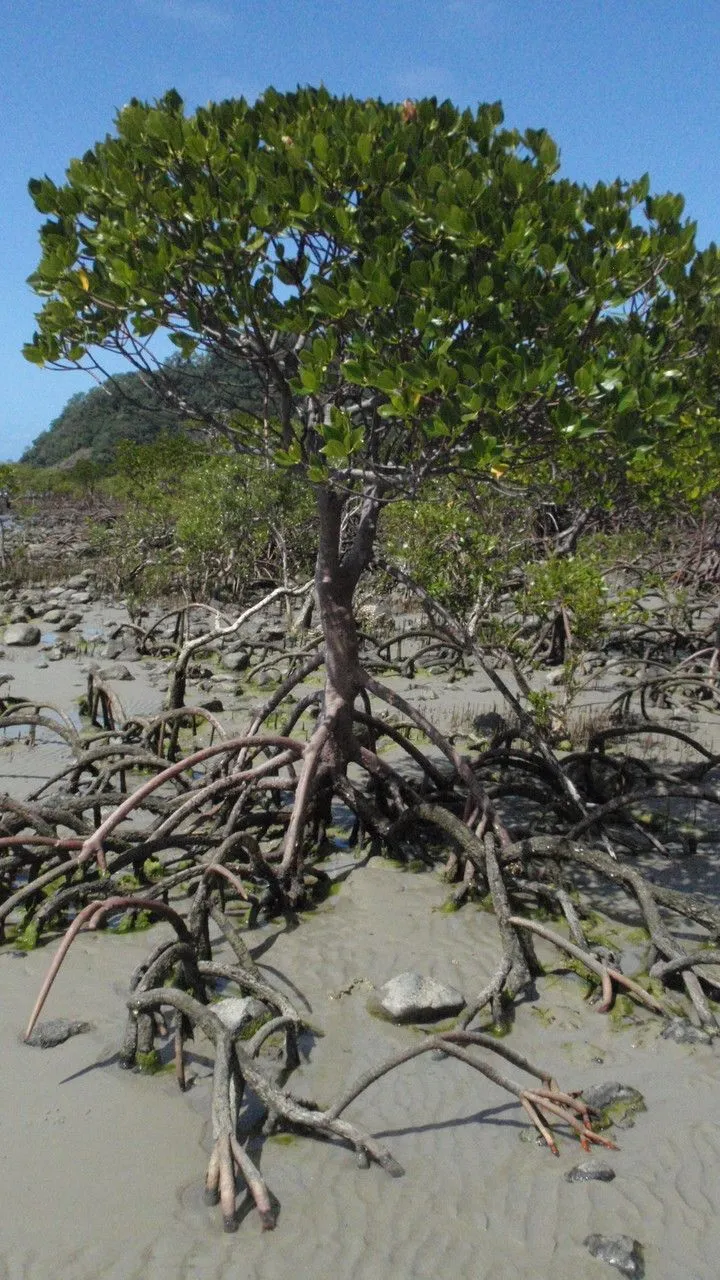
Author: Poir.
Bibliography: J.B.A.M.de Lamarck, Encycl. 6: 189 (1804)
Year: 1804
Status: accepted
Rank: species
Genus: Rhizophora
Vegetable: False
Observations: Red Sea to Indian Ocean and N. & NE. Australia
The loop-root mangrove, scientifically known as Rhizophora mucronata, is an integral species within coastal and estuarine ecosystems. Described by Poir., and cataloged by J.B.A.M. de Lamarck in 1804 in the renowned “Encyclopedie,” this plant belongs to the Rhizophoraceae family. It is native to a wide geographic range spanning the Red Sea, the Indian Ocean, and extending to the northern and northeastern coastal regions of Australia.
Characterized by its distinctive looping roots, Rhizophora mucronata plays a critical role in stabilizing shorelines and protecting coastal areas from erosion. The roots provide a complex habitat for numerous aquatic species, which leverage the root structures for shelter and breeding grounds. Additionally, these roots facilitate sediment accumulation, thereby enhancing the ecological productivity of coastal zones.
The ecological significance of the loop-root mangrove cannot be understated. It contributes to the health of marine environments by filtering pollutants and improving water quality. The dense canopy of Rhizophora mucronata also serves as a crucial buffer against storm surges and extreme weather events, thus safeguarding inland areas and communities.
The loop-root mangrove’s presence in diverse regions, from the Red Sea to the sprawling coastlines of northeastern Australia, underscores its adaptability to different saline environments. Its propagation and growth are vital for maintaining biodiversity and ensuring the resilience of coastal ecosystems faced with the challenges of climate change and human activities.
Efforts to conserve and restore Rhizophora mucronata populations are essential, given their extensive contributions to coastal protection and environmental stability. Researchers and environmentalists continue to study this species to better understand its ecological dynamics and to develop strategies to mitigate the adverse impacts on mangrove habitats globally.
Msa: bakau kurap
Swe: asiatisk mangrove
Eng: loop-root mangrove, mangrove, red mangrove, true mangrove, asiatic mangrove
En: Loop-root mangrove, Red mangrove, Mangrove, Asiatic Mangrove, Bangka u, ကင်တၞးဇၞော်၊ တၞံ, True Mangrove
Af: Rooi wortelboom, Rooiwortelboom
Ar: قندل مؤنف
My: ဗြူးခြေထောက်
Zh: 红茄苳
Fi: Otapunamangrove, Otapunamangrovepuu
Hi: खमो
Ms: Pokok Bakau Kurap, Bakau Kurap
Ml: പ്രാന്തൻ കണ്ടൽ
Fa: چندل
Ru: Ризофора остроконечная
Sw: Mkoko
Sv: Asiatisk mangrove
Zh-tw: 紅茄苳
Th: โกงกางใบใหญ่
Ur: Kumri
Vi: Đưng
: Asiatic mangrove
Taken Aug 15, 2011 by Daniel Barthelemy (cc-by-sa)
Taken Apr 1, 1989 by Daniel Barthelemy (cc-by-nc)
Taken Aug 30, 2018 by Kamaria Hassane (cc-by-sa)
Taken Aug 15, 2011 by Daniel Barthelemy (cc-by-sa)
Taken Feb 20, 2022 by Augustin Soulard (cc-by-sa)
Taken Sep 1, 1998 by Daniel Barthelemy (cc-by-nc)
Taken Sep 1, 1998 by Daniel Barthelemy (cc-by-nc)
Taken Aug 15, 2011 by Daniel Barthelemy (cc-by-sa)
Taken Aug 15, 2011 by Daniel Barthelemy (cc-by-sa)
Taken Mar 25, 2021 by susan brown (cc-by-sa)
Taken Jul 23, 2022 by laurent00031 (cc-by-sa)
Taken Sep 2, 2020 by oliveira cristiane (cc-by-sa)
Taken Feb 20, 2022 by Augustin Soulard (cc-by-sa)
Taken Oct 18, 2019 by Preston (cc-by-sa)
Taken Feb 20, 2022 by Augustin Soulard (cc-by-sa)
Taken Jul 23, 2022 by laurent00031 (cc-by-sa)
Taken Dec 30, 2019 by Simon McLeod (cc-by-sa)
Taken Dec 30, 2019 by Simon McLeod (cc-by-sa)
Taken Dec 30, 2019 by Simon McLeod (cc-by-sa)
Taken Aug 30, 2018 by Kamaria Hassane (cc-by-sa)
Taken Aug 11, 2022 by sandrine morel (cc-by-sa)
Taken Aug 30, 2018 by Kamaria Hassane (cc-by-sa)
Taken Mar 25, 2021 by susan brown (cc-by-sa)
Taken Mar 25, 2021 by susan brown (cc-by-sa)
Taken Mar 25, 2021 by susan brown (cc-by-sa)
Taken Oct 11, 2012 by John Tasirin (cc-by-sa)
© copyright of the Board of Trustees of the Royal Botanic Gardens, Kew.
© copyright of the Board of Trustees of the Royal Botanic Gardens, Kew.
© copyright of the Board of Trustees of the Royal Botanic Gardens, Kew.
Growth habit>: Tree
Family: Myrtaceae Author: (F.Muell.) K.D.Hill & L.A.S.Johnson Bibliography: Telopea 6: 402 (1995) Year: 1995 Status:…
Family: Rubiaceae Author: Pierre ex A.Froehner Bibliography: Notizbl. Bot. Gart. Berlin-Dahlem 1: 237 (1897) Year:…
Family: Sapindaceae Author: Koidz. Bibliography: J. Coll. Sci. Imp. Univ. Tokyo 32(1): 38 (1911) Year:…
Family: Asteraceae Author: A.Gray Bibliography: Pacif. Railr. Rep.: 107 (1857) Year: 1857 Status: accepted Rank:…
Family: Fabaceae Author: Medik. Bibliography: Vorles. Churpfälz. Phys.-Ökon. Ges. 2: 398 (1787) Year: 1787 Status:…
Family: Aspleniaceae Author: (Cav.) Alston Bibliography: Bull. Misc. Inform. Kew 1932: 309 (1932) Year: 1932…